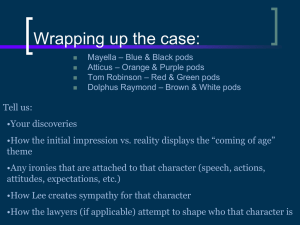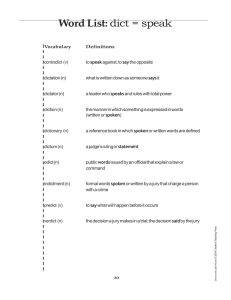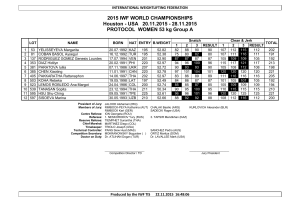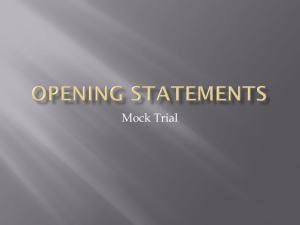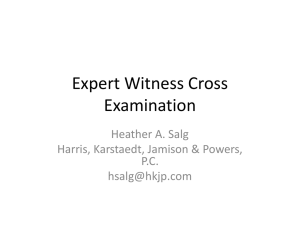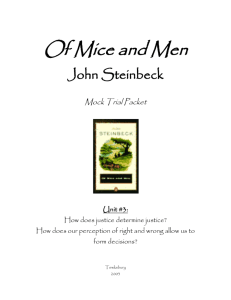Theory of the Case
advertisement
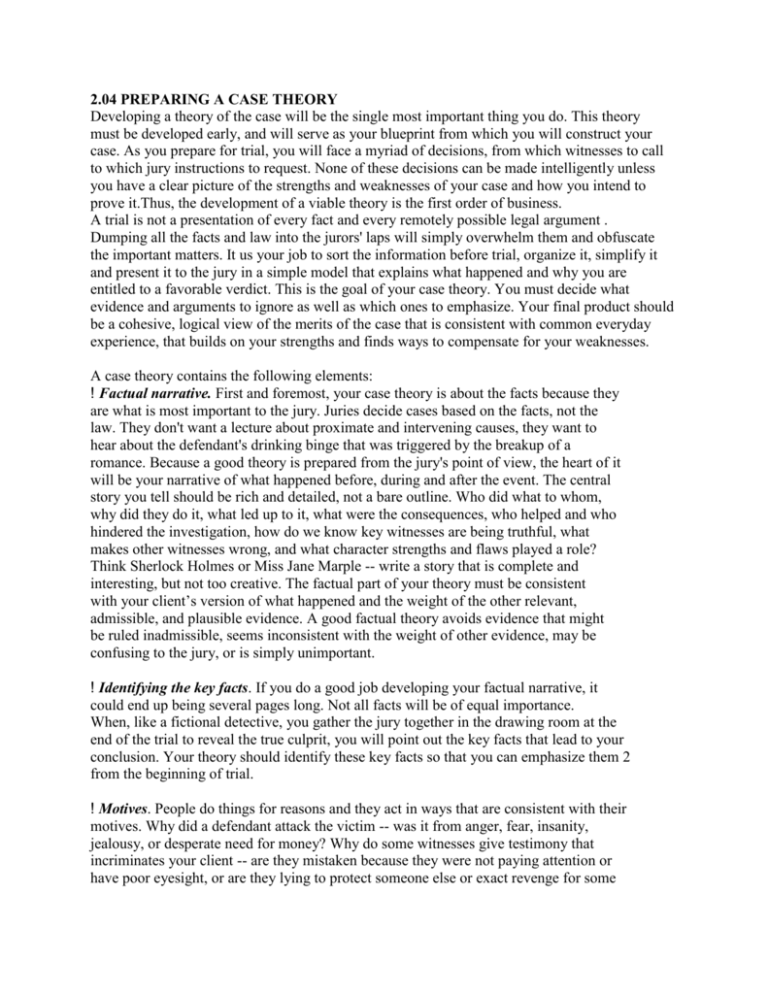
2.04 PREPARING A CASE THEORY Developing a theory of the case will be the single most important thing you do. This theory must be developed early, and will serve as your blueprint from which you will construct your case. As you prepare for trial, you will face a myriad of decisions, from which witnesses to call to which jury instructions to request. None of these decisions can be made intelligently unless you have a clear picture of the strengths and weaknesses of your case and how you intend to prove it.Thus, the development of a viable theory is the first order of business. A trial is not a presentation of every fact and every remotely possible legal argument . Dumping all the facts and law into the jurors' laps will simply overwhelm them and obfuscate the important matters. It us your job to sort the information before trial, organize it, simplify it and present it to the jury in a simple model that explains what happened and why you are entitled to a favorable verdict. This is the goal of your case theory. You must decide what evidence and arguments to ignore as well as which ones to emphasize. Your final product should be a cohesive, logical view of the merits of the case that is consistent with common everyday experience, that builds on your strengths and finds ways to compensate for your weaknesses. A case theory contains the following elements: ! Factual narrative. First and foremost, your case theory is about the facts because they are what is most important to the jury. Juries decide cases based on the facts, not the law. They don't want a lecture about proximate and intervening causes, they want to hear about the defendant's drinking binge that was triggered by the breakup of a romance. Because a good theory is prepared from the jury's point of view, the heart of it will be your narrative of what happened before, during and after the event. The central story you tell should be rich and detailed, not a bare outline. Who did what to whom, why did they do it, what led up to it, what were the consequences, who helped and who hindered the investigation, how do we know key witnesses are being truthful, what makes other witnesses wrong, and what character strengths and flaws played a role? Think Sherlock Holmes or Miss Jane Marple -- write a story that is complete and interesting, but not too creative. The factual part of your theory must be consistent with your client’s version of what happened and the weight of the other relevant, admissible, and plausible evidence. A good factual theory avoids evidence that might be ruled inadmissible, seems inconsistent with the weight of other evidence, may be confusing to the jury, or is simply unimportant. ! Identifying the key facts. If you do a good job developing your factual narrative, it could end up being several pages long. Not all facts will be of equal importance. When, like a fictional detective, you gather the jury together in the drawing room at the end of the trial to reveal the true culprit, you will point out the key facts that lead to your conclusion. Your theory should identify these key facts so that you can emphasize them 2 from the beginning of trial. ! Motives. People do things for reasons and they act in ways that are consistent with their motives. Why did a defendant attack the victim -- was it from anger, fear, insanity, jealousy, or desperate need for money? Why do some witnesses give testimony that incriminates your client -- are they mistaken because they were not paying attention or have poor eyesight, or are they lying to protect someone else or exact revenge for some past wrong? Part of your theory must assign plausible motives to the important actors and witnesses. This step also must be based on evidence -- before you attribute behavior to jealousy or anger, you must have some evidence that the person had a reason to be jealous or angry. ! Law. Your theory must also contain a clear statement of what you think is the proper legal outcome of the case. What verdict should the jury reach, and why? You cannot afford to waffle here -- you can't tell the jury that your client didn't shoot the victim, but if he did, it was in self-defense. There are almost always multiple legal arguments you could make, and you . must decide what is your strongest. . This is a pragmatic inquiry in which you ask what outcome is supported by the evidence and consistent with common sense. You should avoid the trap of wishfully thinking that just maybe the jury will give you an even better outcome by finding in your favor on a weak issue. . For example, a defendant in a personal injury case could argue that there was no negligence, there was no proximate cause, , that plaintiff suffered only minimal damages, that the accident was unavoidable, or that it was 50% plaintiff's own fault, but you can't very well argue all of these legal theories. . If you represent a defendant who, at the time of an accident, was drunk, speeding, driving in the wrong lane, and did not have a license, you would have to be delusional to even consider a theory that he was not negligent, that his behavior was not a proximate cause of the ensuing wreck, or that the accident was unavoidable. If the plaintiff suffered only whiplash injuries that cannot be medically verified, and was not wearing her seatbelt, your theory of the case can more comfortably rest on an argument that the provable damages are small and that the plaintiff was contributorily negligent. . You may have to concede that your client is going to have to pay some damages, but this is far better than making the idiotic argument that he should get off scot-free. ! Emotions. A good theory also looks at the emotional content of your case. If a jury is on your side emotionally and wants to return a verdict for your client, it will usually find a way to do so. . Has an injustice has been committed? Is your client entitled to sympathy? Will your case arouse nostalgia, sentimentality, a sense of community spirit, patriotism, or righteous indignation? Are children and pets involved? There will usually be at least some aspects of your case that will generate positive emotional 3 reactions in the jury. Even if you represent a heinous criminal, you may be able to generate some sympathy if he had a tough childhood or was abused. The flip side of this examination of emotional content is that you must anticipate and be prepared to deal with emotions that will be aroused against you. Will the jury dislike your client or your case? Will some jurors harbor racist or sexist attitudes that may be triggered by the facts of the case? Will you have to deal with negative stereotypes because your client is young, old, tatooed, obese, unemployed, an ex-felon, or Islamic? . A good theory takes account of all these emotional issues, and develops a strategy for emphasizing the positive ones and minimizing the negative. ! Weaknesses. You must recognize, acknowledge, and have an explanation for weaknesses in your case. By weaknesses, we mean inherent problems in your own case that arise regardless of what your opponent does, not disputes that arise from conflicts in the evidence. A weakness is a gap, inconsistency, improbability, or flaw in your theory. They arise when key facts cannot be proved, are uncorroborated, come from witnesses with credibility problems, or are remembered differently by two of your own witnesses. Other kinds of weaknesses include character flaws in your important witnesses, the need to rely on legal technicalities, unfavorable associations, and places where your case is inconsistent with common sense. Part of the planning process is to decide whether a weakness is important enough for you to acknowledge in your own case, and if so, how you will reduce its negative effect. ! Opponent’s case. Remember that there is a lawyer on the other side who will be trying to sell the jury a story that contradicts yours. In the trial to come, you therefore will have to play defense as well as offense. If both sides do competent jobs, the jury will have to choose between two competing versions of events, and the more you can demonstrate the implausibility of your opponent's case, the more likely it is the jury will accept yours. . Analyze your opponent’s case to determine where the disputes will arise and where your opponent is strong and weak. . Use this information to decide where to attack the other side. A good strategist emphasizes his or her own strengths and attacks the other side's weaknesses. This part of the theory is critical, because it is counterproductive to try to attack the other side's strengths. Such attacks fail, and if you fail often enough, it makes your opponent's case look invincible. ! Short summary. Finally, your theory needs a good three- or four-sentence summary that wraps up your case and tries to capture in a few words all they key elements of your theory: Who did what to whom and why did they do it? What was the result? What are the legal and moral reasons this requires a verdict in your favor? What is your single most important item of evidence, and your best response to the other side's case?


